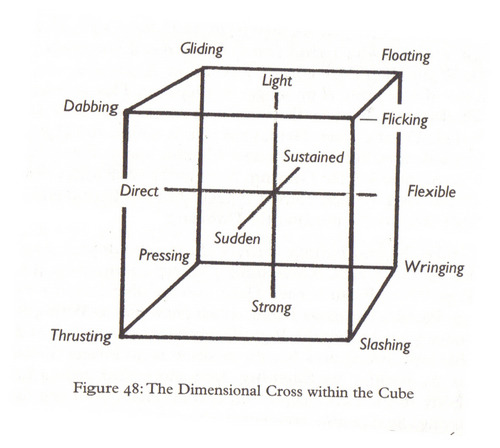|
Consist posted:Some examples: I mean, without context it seems insane, but I have genuinely redrawn this exact diagram several times to explain concepts to people.
|
|
|
|

|
| # ¿ Apr 23, 2024 11:10 |
|
Twerkteam Pizza posted:No I get that there's a method/logic behind it, I just want an explanation because I personally do not understand it. I looked up Labanotation and found that it's a thing, but even after reading wikipedia and another introduction I am lost. There's 3 axis of effort, which define the "space". This is a map of that space, as a 3D cube, with the extreme points marked. By thinking in these 3 terms, you can keep the movement of a particular character consistent, and you can also think about how to make other characters stand in contrast to them. Eg. if one character "glides" in general (making Sustained, Light but Direct movements) then the are doing things purposefully with little effort. By contrast you could make the opposing character act in a "slash" way (taking Quick, Heavy and Indirect actions) where they are using a lot of energy to do things in a more staccato and less focused way. I could easily see that being a scene about how one character is going about a task with ease and grace, and the other being frustrated and envious as they try to emulate it but fail and increasingly become more the OPPOSITE of the motions they are trying to copy. That's a really coarse example, you can do more fine-grained things by also having just one axis be different. Using this cube to analyse and place stuff like that can be really useful. I work in games now, but I continue to find it useful as a tool for just placing things. If you were doing weapons in something like Quake 3, you can analyse their projectiles in a similar way and put them in this space. There are places in that where weapons are fixed, like a Rocket Launcher is always going to be Direct, Sustained, Heavy sort of projectile. But what does an Ion Gun do? If you find empty space in your movement graph, then you might want it to visually sit in that space because it will then "feel" different to the other gun (rather than feeling like a reskin of it) and other players will be able to distinguish the different types of incoming fire easier. Our eyes have like 10x as many receptors to movement than colour, particularly in the periphery, and yet people don't put as much weight in "movement coding" things as "colour coding" them. This is my "RGB" for when i'm trying to differentiate or make things similar. As an artist it's easy (if annoying) when people say "Can you make it more blue". When dealing with motion people tend to lack the vocabulary to discuss what they find wrong, and I find that graph helpful to discussion. MissMarple has a new favorite as of 14:56 on Oct 29, 2015 |
|
|
|
I'm mostly just upset that the scale is $/m and not m/$ because clearly the author wanted to show video games as the big winners.
|
|
|
|
Hippie Hedgehog posted:From an annual report of a pretty major company (50k+ employees). These are useful because you might see overall YoY of +/-0%, but with the breakdown it’s because of growth in one area cancelling out shrinkage in another. As for the reporting, I’d guess this was guidance or estimates from before the start of the year.
|
|
|
|
Platystemon posted:O.K. but why do Europe and Latin America comprise a region?
|
|
|






